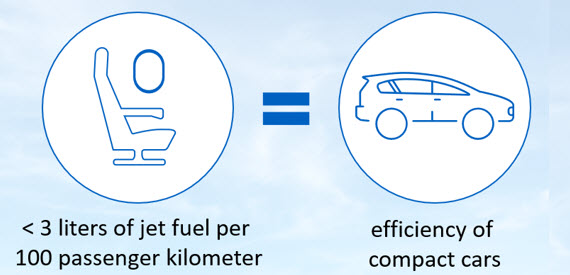

 Climate change is top of mind for everyone. We see many climate marches attended by thousands of people around the world, and it is a hot topic of discussion - rightfully so.
Climate change is top of mind for everyone. We see many climate marches attended by thousands of people around the world, and it is a hot topic of discussion - rightfully so.
With a strong commitment to corporate social responsibility, this is top of mind for us too at CAE, and you might be wondering – how do we reconcile this with the fact that we are working in the aviation industry? Where do we stand when we see news articles and activists who encourage people to stop travelling by plane because of the carbon footprint generated by the aviation industry?
When I joined the aviation industry 12 years ago, it was a concern for me too. That is why it is important to know the facts. Let me explain.
Aviation is responsible for 2% of worldwide CO2 emissions. As a comparison, the internet is responsible for roughly as much emissions (2%) and the car industry is responsible for 15%.

But our industry has taken a commitment to reduce CO2 emissions by 50% by 2050, relative to 2005 (business aircraft manufacturers have signed this commitment too).
Our industry was the first to make such a bold commitment 10 years ago. And there is a plan to make this environmental commitment happen, which takes into account passenger air traffic growth.
The industry is constantly looking at new ways to be greener:
Using biofuels
Biofuels have now been certified and are used by various airlines. They have been shown to reduce the carbon footprint of aviation fuel by up to 80% over their full lifecycle. It’s now only a question of price and availability before biofuels can reduce CO2 emissions of aircraft in service.
New aircraft types
We have seen more environmentally-friendly aircraft enter into service in the last 10 years, like the Airbus A220 with its 20% better fuel-burn and reduced noise footprint.
Recent aircraft use less than 3 liters of jet fuel per 100 passenger kilometer. This matches the efficiency of the most modern compact cars, while travelling much further and much faster. About 80% of aviation CO2 emissions are emitted from flights over 1,500 kilometres for which there is no practical alternative mode of transportation.

Airlines and air traffic management
Airlines are saving fuel through more efficient procedures and weight reduction measures. Some airlines taxi to the runway on one engine instead of using two.
Air traffic management systems are being improved by making better use of airspace design and optimising flight operations to use more direct routes.
And we play a role too!
We can be proud of the role we play: type-rating and training pilots only on flight simulators, like we are doing, is avoiding millions of tons of CO2 emissions every year and aircraft usage/wear.
CAE constantly innovates to increase the use of synthetic training environments. With CAE Rise, we enable instructors to deliver trainings in line with the customers’ requirements, including en-route flight efficiency.
We keep developing the next generation of simulation platforms and we are continually improving our environmental performance by finding solutions to minimize the environmental impacts of its operations.
Well aware of the potential risks linked to climate change, CAE has created a Climate Change Committee that will develop potential risk scenarios for CAE. For example, we will analyze risks for our facilities resulting from extreme weather events such as tornadoes, hurricanes or floods for example, and a potential course of action.
Looking forward
Any emissions that the aviation industry is unable to reduce through technological, operational or infrastructural measures, or by using sustainable aviation fuels, will need to be offset by market-based measures from 2020.
ICAO (the International Civil Aviation Organization) has adopted CORSIA - short for the Carbon Offsetting and Reduction Scheme for International Aviation - the world's first global scheme to offset the growth in international aviation CO2 after 2020. As the name suggests, under CORSIA, airlines and other aircraft operators will offset any growth in CO2 emissions above 2020 levels. This means that aviation’s net CO2 emissions will be stabilised, while other emissions reduction measures are pursued.
The aviation industry is concerned by climate change and is taking a clear stand. We can be proud of what our industry is doing to reduce CO2 emissions. Now, our challenge is to make the industry plan known to the general public. All industry players, including us, have a role to play in that regard. Pass the word!
For more infomation, visit the Air Transport Action Group, Aviation Benefits Beyond Borders, or download our FY19 Annual activity and corporate social responsibility report.
Learn more on CAE's plan: CAE announces its plan to become carbon neutral in Summer 2020